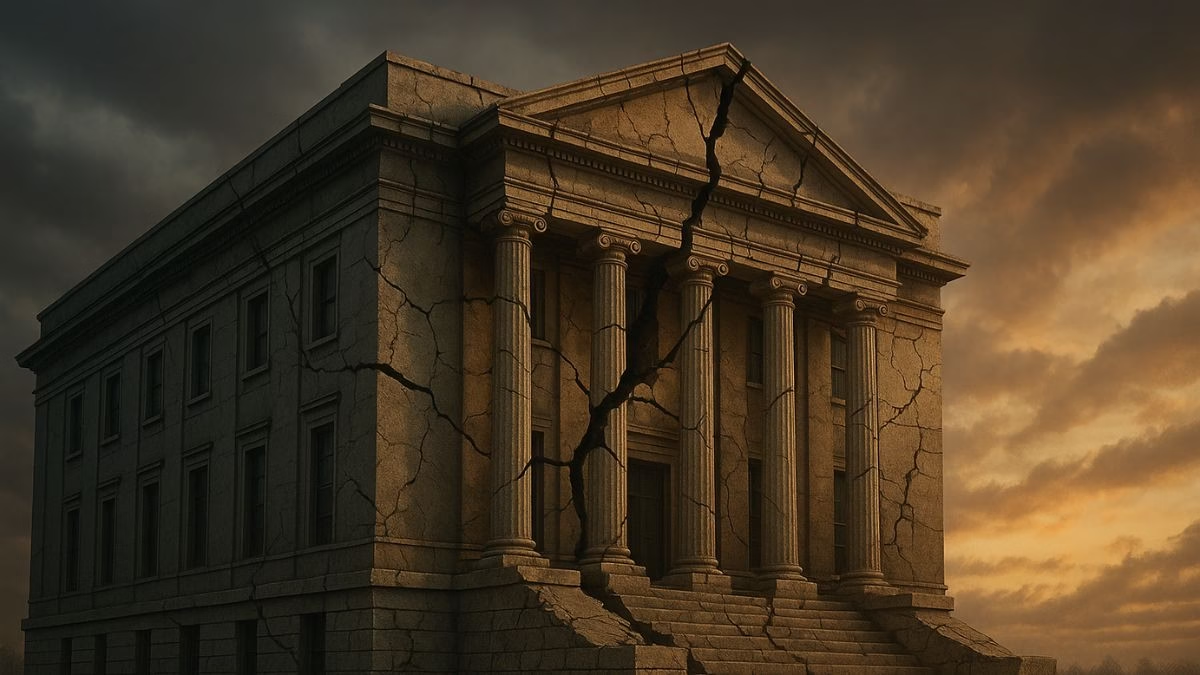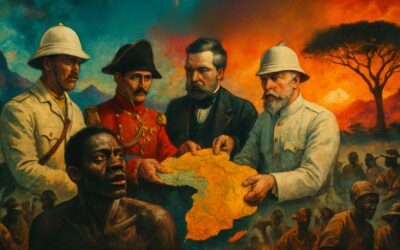- Audio Article
- The Cracks in Our Foundation
- The Fourth Estate Under Siege: The Implosion of Media Trust
- The War on Knowledge: When Science Becomes an Opinion
- The Withering of Governance: Losing Faith in the State
- Rebuilding in the Rubble
- MagTalk Discussion
- Focus on Language
- Vocabulary Quiz
- Let’s Discuss
- Learn with AI
- Let’s Play & Learn
Audio Article
The Cracks in Our Foundation
Modern society is a miracle of cooperative engineering. It’s a sprawling, impossibly complex structure built not on steel and concrete, but on a foundation far more abstract and fragile: trust. We trust that the money in our pockets has value, that the food in our stores is safe to eat, that the car driving towards us will stay in its lane. More broadly, we operate on a baseline of trust in the large-scale institutions that manage this complexity—the media to inform us, the government to govern us, science to guide us, and medicine to heal us. For most of modern history, this foundational trust, while sometimes tested, has held. Now, it is cracking under the weight of a sustained, industrial-scale assault.
We are living through a crisis of belief, fueled by an infodemic that has polluted our shared information ecosystem. This is not simply about people believing the odd piece of fake news. It is a far more profound and dangerous phenomenon. The constant barrage of conflicting narratives, weaponized falsehoods, and hyper-partisan propaganda is systematically dissolving the glue that holds a pluralistic society together. The ultimate casualty of the disinformation age is not truth itself, but our trust in any institution that claims to be an arbiter of truth.
This article takes a step back from the daily skirmishes of the information war to assess the long-term, societal-level damage. It is a sociological post-mortem of a shared reality in decline. We will examine, pillar by pillar, how this erosion of trust is manifesting—in our relationship with the press, our faith in the scientific method, our confidence in our own governments, and our reliance on medical expertise. Using case studies that have defined our era, from the intractable battle over climate change to the tragic consequences of the anti-vaccine movement, we will illustrate the tangible, often devastating, harm that occurs when a society can no longer agree on a common set of facts. This is the story of what we lose when seeing is no longer believing.
The Fourth Estate Under Siege: The Implosion of Media Trust
The media, often called the “Fourth Estate,” was conceived as the watchdog of democracy. Its institutional role is to hold power accountable, to investigate wrongdoing, and to provide the public with the verified information necessary for self-governance. This requires a compact of trust between the journalist and the citizen. That compact has been shattered.
From Watchdog to “Enemy of the People”
The assault on the media has been a multi-pronged and devastatingly effective campaign. It began by blurring the lines between established news organizations with rigorous editorial standards and hyper-partisan blogs or state-sponsored propaganda outlets. In the flattened, context-free landscape of a social media feed, a deeply reported investigation from the Wall Street Journal can be made to look equivalent to a conspiracy theory posted on a fringe website.
This initial blurring was followed by a direct, relentless attack on the credibility of journalists and news organizations themselves. The very act of reporting inconvenient facts was reframed as a partisan attack. The charge of “fake news,” originally used to describe fabricated content, was masterfully co-opted and turned into a political cudgel to be wielded against any legitimate reporting that a political actor disliked. This strategy did more than just discredit a single story; it sought to discredit the entire process of journalism.
The result is a crisis of legitimacy. A significant portion of the public no longer sees the mainstream media as an imperfect but essential institution striving for objectivity, but as a malicious entity actively pushing a political agenda. Every story is viewed through a lens of extreme cynicism. A typo is not a mistake; it’s evidence of a deliberate lie. An anonymous source is not a protected whistleblower; it’s a fabrication. This corrosive skepticism makes the media’s job of holding power to account nearly impossible. When a watchdog barks, but half the neighborhood is convinced it’s a wolf in disguise, the warning goes unheeded.
The Paralysis of a Post-Trust Democracy
The tangible consequence of this implosion is political paralysis and the decay of democratic norms. When a shared set of facts is no longer available, good-faith debate becomes impossible. We retreat into hermetically sealed information bubbles, consuming only the “news” that confirms our existing biases. In this environment, compromise is seen as betrayal, and political opponents are not just people with different opinions, but enemies with different, irreconcilable realities.
A democracy cannot function under these conditions. How can we debate the best way to fix the economy when we can’t agree on whether unemployment is going up or down? How can we hold leaders accountable for a scandal if a large part of the population has been convinced the scandal was manufactured by a hostile press? The erosion of trust in the media is not an esoteric problem for journalists; it is an existential threat to the operating system of democracy itself.
The War on Knowledge: When Science Becomes an Opinion
If the media is the watchdog, then science is the compass. The institution of science is our most powerful method for understanding the physical world. It is a slow, methodical, self-correcting process of observation, experimentation, and peer review designed to filter out bias and arrive at the most accurate description of reality possible. Its authority rests on this rigorous process, not on personality or politics. Disinformation, however, has found a way to attack the very foundations of this process, turning scientific consensus into just another “opinion” in the marketplace of ideas.
Manufacturing Doubt, Selling Paralysis: The Climate Change Case Study
The campaign against climate science is perhaps the most well-documented and consequential example of institutional trust erosion. For decades, a coordinated and well-funded effort by fossil fuel interests and ideological actors has worked not to disprove the science of climate change—an impossible task—but to manufacture the illusion of a scientific debate.
The tactics are a masterclass in anti-science propaganda. They elevate the voices of a handful of dissenting scientists, presenting them as brave mavericks fighting a corrupt establishment, thus creating a false equivalency that makes a 99% scientific consensus seem like a 50/50 debate. They cherry-pick data, highlighting an unusually cold winter in one region to “disprove” the trend of global warming. They attack the integrity of climate scientists themselves, accusing them of faking data for personal financial gain.
The goal of this campaign was never to win the scientific argument. It was to sow just enough public doubt to paralyze political action. And it has been catastrophically successful. By eroding public trust in the institution of climate science—in the peer-review process, in the academic institutions, in the scientists themselves—they delayed meaningful policy action for decades. The tangible result is all around us: more extreme weather events, rising sea levels, and a planet pushed closer to irreversible tipping points. The war on climate science demonstrated that you don’t need to win the debate if you can convince the public that the referees are biased.
The Tragic Cost of Rejecting Expertise: The Anti-Vaccine Movement
A similar playbook has been used with even more immediate and tragic consequences in the realm of public health. The modern anti-vaccine movement, supercharged by social media, represents a profound rejection of the institution of medicine. It attacks the very concept of expertise, arguing that the “research” of a celebrity or a wellness blogger on Instagram is just as valid as the recommendations of the Centers for Disease Control and Prevention (CDC) and a global consensus of immunologists.
This movement thrives on the erosion of trust in every related institution. Pharmaceutical companies are cast as greedy villains, government agencies like the FDA as corrupt cronies, and doctors as either ignorant pawns or willing participants in a grand conspiracy. This narrative found fertile ground during the COVID-19 pandemic, leading to widespread resistance to masking, social distancing, and, most critically, life-saving vaccines.
The tangible harm is not abstract or in the future; it is measured in hospital beds and death tolls. The rejection of medical and scientific consensus led to countless preventable deaths and prolonged the pandemic’s grip on society. It showed that when trust in institutions like science and medicine collapses, the consequences are not just political or academic. They are written on death certificates.
The Withering of Governance: Losing Faith in the State
The final pillar of trust under assault is perhaps the most foundational: trust in government itself. Government, in its ideal form, is the institution we create to manage our collective affairs, provide for the common defense, and ensure a baseline of order and justice. It is the ultimate arbiter of rules in a complex society. When trust in its legitimacy, its competence, and its motives withers, the very fabric of social order begins to fray.
From Healthy Skepticism to Corrosive Cynicism
A certain level of skepticism toward government is a healthy and necessary feature of a free society. It is the attitude that animates investigative journalism and keeps power in check. But the goal of many modern disinformation campaigns is to push the public beyond healthy skepticism into a state of deep, corrosive cynicism.
This is achieved by relentlessly promoting narratives of universal corruption, incompetence, and malevolence. Every government action, no matter how benign, is framed as part of a nefarious plot. Public servants are not dedicated professionals, but “deep state” operatives. Elections are not the will of the people, but elaborate, rigged charades. This constant barrage of negativity creates a feedback loop. As people lose faith in the government’s ability to solve problems, they become less willing to participate, pay taxes, or cooperate with public initiatives, which in turn makes it even harder for the government to solve problems, thus “proving” its incompetence.
The Danger of a Society That Doesn’t Believe in Itself
When citizens cease to believe in the legitimacy of their own government, the consequences are dire. At a basic level, it makes public administration impossible. How do you conduct a national census if a huge portion of the population believes it’s a scheme to confiscate their property? How do you manage a public health crisis if people refuse to cooperate with contact tracers, believing them to be government spies?
At a more profound level, it unravels the social contract. The peaceful transfer of power, the rule of law, and respect for democratic processes all depend on a shared belief in the legitimacy of the system, even when we don’t like the outcome. When that belief dies, as evidenced by the storming of legislative buildings and widespread claims of electoral fraud, the alternative is not a better government, but a failed state where political disputes are settled not by ballots, but by force.
Rebuilding in the Rubble
The erosion of trust in our core institutions is not a side effect of the infodemic; it is, in many ways, its primary objective. Disinformation flourishes in the soil of cynicism and distrust. By weakening the authority of the press, science, medicine, and government, purveyors of falsehood clear the field of any competing source of truth, leaving their own narratives to fill the void.
We are now living in the rubble of this deconstruction. The tangible harms are clear—a warming planet, a resurgent measles virus, a democracy teetering on the brink. Rebuilding this trust is the central challenge of our time, and it will be a monumental undertaking. It will require institutions to become radically more transparent and accountable to earn back their legitimacy. It will require a massive investment in media and science literacy to equip citizens with the tools of critical thinking. And it will require all of us to make a conscious choice: to resist the allure of simple, cynical narratives and to re-engage with the messy, difficult, but essential work of building a shared reality. The foundation is cracked, but it has not yet collapsed. The time to start repairs is now.
MagTalk Discussion
Focus on Language
Vocabulary and Speaking
Let’s zoom in and talk about some of the specific words we used to build the argument in that article. When you’re tackling big, sociological ideas like the erosion of trust, you need a vocabulary that’s as solid and precise as the concepts themselves. These words aren’t just for sounding smart; they’re tools that allow you to describe the world with greater nuance and power. Let’s break a few of them down.
We’ll start with the central concept itself: erosion. We talked about the “erosion of trust in institutions.” The literal meaning of erosion is the gradual destruction of something by natural forces, like wind, water, or acid. Think of a coastline slowly being eaten away by the waves, or a statue’s features being worn down by acid rain over centuries. It’s not a sudden explosion; it’s a slow, steady, and relentless wearing away. This metaphor is perfect for describing what’s happening to trust. It didn’t vanish overnight. It’s being gradually worn down by a constant barrage of corrosive information. You can use this word to describe the gradual decline of anything. For example, “The constant stress led to an erosion of his health.” Or, “The company’s terrible customer service caused a slow erosion of its brand loyalty.” It’s a fantastic word for a slow, destructive process.
Next up is the word barrage. We mentioned a “constant barrage of conflicting narratives.” A barrage is a concentrated, overwhelming, and continuous attack. The word originally comes from a military context, describing a heavy artillery bombardment. When you hear the word barrage, I want you to picture that: a rapid, non-stop assault. It’s not just “a lot of” information; it’s an amount so overwhelming that it’s difficult to defend against. This is exactly what the modern media environment feels like. It’s a barrage of notifications, headlines, and opinions. You can use it in many contexts to mean an overwhelming quantity of something delivered in a short time. “After the scandal broke, the politician faced a barrage of questions from reporters.” Or, on a lighter note, “When they announced the concert tickets were on sale, the website was hit with a barrage of traffic and crashed.”
Let’s look at the word tangible. We used it to describe the “tangible, societal-level harm” caused by this erosion. Something is tangible if it is perceptible by touch. It’s real, definite, and can be physically felt. We use it to contrast with things that are abstract, theoretical, or hypothetical. The erosion of trust is an abstract concept, but its consequences—like overflowing hospitals or raging wildfires—are tangible. They are real-world outcomes that you can see and measure. This is a crucial word for making an argument. If you want to show that an abstract problem is serious, you need to point to its tangible effects. “While the company’s culture was toxic, it wasn’t until we saw the tangible drop in sales that the board took action.” Or, “The goal of the charity is to provide tangible support, like food and shelter, to those in need.”
Now for a word that describes the foundation of it all: bedrock. While not in the final text, it’s a perfect synonym for the “foundation” of trust we talked about. Bedrock is the solid, unweathered rock that lies beneath the loose surface deposits of soil and gravel. It is the absolute, solid foundation upon which everything else is built. When you refer to something as the bedrock of something else, you are saying it is the fundamental principle or core support. “Honesty is the bedrock of any healthy relationship.” Or, “The principle of equality is the bedrock of the legal system.” To say that trust is the bedrock of society means that if it disappears, the entire structure built on top of it is in danger of collapse. It’s a word that conveys immense foundational importance.
Let’s talk about another great word to describe a process: insidious. Like erosion, insidious describes something that is harmful, but its key characteristic is that it proceeds in a gradual and subtle way, with its harm not being immediately apparent. It’s treacherous and sly. Think of a disease that has no symptoms in its early stages but is doing immense damage internally. Disinformation can be insidious because its effects on our thinking and trust aren’t always obvious at first. We just slowly become more cynical, more polarized, without even noticing the change. “The pernicious influence of the charismatic cult leader was insidious; his followers didn’t realize they were being manipulated until it was too late.” Or, “Procrastination can be an insidious habit; it slowly undermines your productivity without you even realizing it.”
Here’s a word that’s central to science and public debate: consensus. We talked about the scientific consensus on climate change. A consensus is a general agreement among a group of people. It’s not the same as a unanimous vote. It doesn’t mean every single person agrees on every single detail. It means that the vast, overwhelming majority of experts in a field, after looking at all the evidence, have arrived at the same general conclusion. The attack on science is often an attack on the very idea of consensus, trying to make it seem like a conspiracy to suppress dissent. This word is crucial for understanding how knowledge is built. You could say, “After a long meeting, the committee finally reached a consensus on the new budget.” Or, “There is a growing consensus among economists that the policy is not working.”
Now for a word that describes what happens to the social fabric: fray. We said the fabric of social order begins to fray. To fray means to unravel or become worn at the edge, typically through constant rubbing or strain. Think of the cuffs of an old pair of jeans, where the threads start to come loose. When we say society or a relationship begins to fray, we mean that it’s starting to show signs of stress and break down at the edges. It’s not broken yet, but the connections are weakening. “After weeks of pressure, his nerves began to fray.” Or, “The coalition started to fray as the different parties disagreed on key issues.” It’s a wonderful visual metaphor for something beginning to fall apart under stress.
Let’s look at the word that describes the attitude that replaces trust: cynicism. We talked about people moving from healthy skepticism into “deep, corrosive cynicism.” A cynic is a person who believes that people are motivated purely by self-interest rather than acting for honorable reasons. Cynicism, therefore, is that inclination to believe the worst of people and institutions. It’s the default assumption that everyone has a selfish, ulterior motive. While skepticism is about questioning things and asking for evidence, cynicism is about dismissing them out of hand. It’s a very corrosive attitude. “His past betrayals had filled him with a deep cynicism about love.” Or, “There’s a growing cynicism among voters about the entire political process.”
And what does that cynicism lead to? Polarization. Polarization is the division of something into two sharply contrasting groups or sets of opinions. Think of the North and South Poles—two opposite extremes. When a society becomes polarized, the moderate middle ground disappears, and people are pushed into opposing camps. Disinformation thrives on and accelerates polarization, creating an “us vs. them” mentality. “The debate over the new law has led to a sharp polarization of public opinion.” Or, “Social media algorithms can sometimes increase political polarization by only showing people content they already agree with.”
Finally, a word for the role these institutions are supposed to play: arbiter. We said trust is collapsing in any institution that “claims to be an arbiter of truth.” An arbiter is a person or institution that has the ultimate authority to settle a dispute or decide a matter. A referee in a football game is the arbiter of the rules. A judge is the arbiter of a legal case. Institutions like science and journalism have traditionally been seen as arbiters of what is factually true. When we lose trust in them, we are left without a referee, in a game with no rules. “The Supreme Court is the final arbiter of constitutional issues.” Or, “In our family, my grandmother was the ultimate arbiter of any dispute.”
These words are your equipment for dissecting the complex social dynamics of our time.
Now, let’s talk about a speaking skill. The topic of this article is heavy, and it’s easy to sound preachy or accusatory when discussing it. The skill I want you to focus on is acknowledging complexity and nuance. Black-and-white thinking is what gets us into this mess; nuanced thinking is what gets us out. When you speak about a sensitive topic, you can build trust and sound more credible by showing that you see multiple sides of the issue. The key is to use concessive clauses—phrases that grant or concede a point. These often use words like “while,” “although,” “even though,” “of course,” and “to be sure.”
For example, instead of saying, “The media is corrupt,” which is a simplistic, polarizing statement, you could say: “While the media certainly has its flaws and biases, its role as a watchdog is still essential for democracy.” See what happened there? You acknowledged the valid criticism first, which makes your main point stronger and more believable.
Here’s your challenge: The next time you’re in a discussion about a complex or controversial topic (politics, social issues, etc.), I want you to consciously practice this technique. Before you state your main point, start with a concessive clause that acknowledges a valid point from the other side, or that recognizes the complexity of the issue. Try phrases like:
“Of course, it’s true that…”
“I understand why some people feel that…”
“To be sure, the situation is not that simple…”
“Although there are problems with X, we also have to consider Y…”
This technique will transform your speaking. It shifts you from being a partisan debater to being a thoughtful contributor. It shows respect for your listener and makes your own arguments more persuasive. Try it.
Grammar and Writing
Let’s turn our attention to the craft of writing about these profound and often personal issues. The article you read took a broad, sociological view of the erosion of trust. Now, we’re going to bring it down to the human level. Writing a compelling personal essay is about connecting your individual experience to a larger universal theme.
Here is your writing challenge:
Write a short personal essay (500-700 words) titled “The Moment I Started to Doubt.” In this essay, reflect on a specific moment or experience when you, or someone you know, felt a significant drop in trust towards a major institution (e.g., the media, the government, science, or medicine). Your goal is not to argue whether the distrust was justified or not, but to explore the feeling of that moment. What caused it? How did it feel to have that foundation of trust crack? What were the consequences for your or their worldview?
This is a powerful exercise in reflective writing. It requires honesty and the ability to articulate complex emotions. To help you craft a moving and insightful essay, let’s focus on two key writing techniques: using concessive clauses to create nuance and structuring your essay with a narrative arc.
First, let’s double down on a concept we introduced in the speaking section: concessive clauses. In writing, especially reflective writing, these are even more crucial. They are your primary tool for showing intellectual honesty and creating a tone of thoughtful exploration rather than simple complaint. A concessive clause acknowledges a point that might seem to contradict your main argument. They typically start with words like although, even though, while, despite, and whereas.
Using them allows you to hold two competing ideas in your head at the same time, which is the hallmark of sophisticated thinking.
Without concession: “The news report about the factory closure was biased. It only focused on the economic impact and ignored the workers.”
With concession: “Although I understood the economic reasons for the factory closure that the news report highlighted, I couldn’t shake the feeling that the human cost—the stories of the workers—was being deliberately ignored.”
The second version is infinitely more powerful. It shows that you are a reasonable person who can see the other side, which makes your ultimate feeling of distrust more compelling and relatable. As you write your essay, constantly look for opportunities to add this kind of nuance. “I had always trusted doctors, but while I knew the doctor was following standard procedure, I felt like a number, not a person.” That “while” clause makes all the difference.
Second, let’s think about structuring your essay like a story. A good personal essay isn’t just a list of thoughts; it has a narrative arc. The simplest and most effective arc for this kind of reflection is the before-and-after structure.
The “Before” (The Setup): Start by establishing your initial state of belief or trust. What was your relationship with this institution before the pivotal moment? This part of the essay establishes the baseline and sets the stakes.
Example: “Growing up, the nightly news was a ritual in our house. It was the voice of authority, a calm, objective narrator of the world’s events. I never thought to question it; the facts were simply the facts.”
The “During” (The Inciting Incident): This is the core of your essay. Describe the specific moment or event that caused the crack in your trust. Use sensory details and focus on the internal emotional experience. This is where you “show, don’t tell.”
Example: “Then came the 2008 financial crisis. I remember watching a government official on TV assuring the public that everything was under control, that the fundamentals were strong. Days later, the market collapsed. It wasn’t just that he was wrong; it was the chilling calmness of his delivery, the sheer certainty in his voice. In that moment, the narrator I had trusted my whole life was suddenly revealed to be just another character, reading from a script.”
The “After” (The Reflection): Conclude your essay by exploring the consequences of this shift. How has your worldview changed? Are you more cynical? More skeptical? How do you navigate the world differently now that this pillar of trust is gone?
Example: “Ever since that day, I listen to official pronouncements with a different ear. The calm certainty no longer reassures me; it unnerves me. The trust I lost was not just in one official, but in the idea that anyone is truly in control. My world is now a more complicated, less certain place, and while that can be frightening, it has also forced me to become a more active, critical seeker of my own truth.”
By using this simple before-during-after structure, you create a compelling journey for the reader. You guide them from a place of certainty, through a moment of disillusionment, to a new, more complex understanding.
So, to summarize your writing mission:
Weave in concessive clauses (using although, while, etc.) to show your ability to see multiple sides of the issue, creating a nuanced and credible voice.
Structure your essay with a clear narrative arc: establish the “before” state of trust, describe the “during” moment of the crack, and reflect on the “after” consequences for your worldview.
This approach will help you transform a personal memory into a powerful, universal story about one of the most important issues of our time.
Vocabulary Quiz
Let’s Discuss
Here are some questions to guide a deeper conversation about the erosion of trust and its consequences. Use them to explore the nuances of the issue and share your own perspectives.
To what extent have institutions (media, government, science) brought this distrust upon themselves through their own past failures, mistakes, or lack of transparency?
Think about historical events that legitimately damaged public trust (e.g., the Tuskegee Syphilis Study in medicine, the reporting failures leading up to the Iraq War in media, the 2008 financial crisis in government/economics). How much of the current crisis is due to malicious disinformation, and how much is a predictable reaction to real institutional failures? Is it possible to rebuild trust without a full accounting of these past mistakes?
The article frames skepticism as healthy but cynicism as corrosive. In your own life, how do you distinguish between the two? Where is the line?
Skepticism involves questioning and demanding evidence, while cynicism involves dismissing things out of hand with a presumption of bad faith. Can you think of a time when you were skeptical versus a time you were cynical? Is it becoming harder to remain a healthy skeptic without slipping into cynicism in the current information environment?
If we can no longer agree on a common set of facts provided by institutions, what takes their place? What are the alternative sources of “truth” and community people turn to?
Consider the rise of charismatic online influencers, tightly-knit conspiracy communities, religious leaders, or even just one’s own “gut feeling.” What are the pros and cons of these alternative sources of authority? Do they provide a sense of belonging that traditional institutions have failed to offer?
What does a “radically more transparent and accountable” institution actually look like in practice? What specific changes could an institution like the media or the government make to start earning back trust?
Brainstorm concrete actions. For media, could it involve showing their work, publicly correcting errors more vigorously, or creating clearer labels between news and opinion? For government, could it mean simplifying bureaucratic processes, holding more town halls, or passing stronger anti-corruption laws? What are the small, tangible steps that could begin to reverse the erosion?
Are you personally more optimistic or pessimistic about our ability to rebuild a high-trust society? What is one thing that gives you hope, and one thing that makes you despair?
Consider the forces working for and against trust. On the pessimistic side, you have polarizing algorithms and the profitability of outrage. On the optimistic side, you might have rising media literacy movements, new technologies for verification, and the basic human desire for community and stability. Where do you think the balance lies?
Learn with AI
Disclaimer:
Because we believe in the importance of using AI and all other technological advances in our learning journey, we have decided to add a section called Learn with AI to add yet another perspective to our learning and see if we can learn a thing or two from AI. We mainly use Open AI, but sometimes we try other models as well. We asked AI to read what we said so far about this topic and tell us, as an expert, about other things or perspectives we might have missed and this is what we got in response.
It’s an important and sobering topic, and the main article provides a robust framework for understanding the crisis. As a sociologist, I’d like to add a layer to this discussion that was hinted at but not fully fleshed out: the concept of social capital and its relationship to institutional legitimacy.
The article correctly identifies trust as the foundation of society. In sociology, we often talk about this through the lens of “social capital.” This isn’t financial capital; it’s the value that exists in our social networks. It’s the trust, the norms of reciprocity, and the sense of shared community that allow us to cooperate and solve collective problems. There are two important types: “bonding” social capital, which is the trust we have in people like us (our family, our close friends, our tribe), and “bridging” social capital, which is the trust we have in people who are different from us and in the broader institutions that connect us all.
A healthy society has a good balance of both. But what we’re seeing in the disinformation age is a dramatic increase in bonding capital at the expense of bridging capital. Disinformation is incredibly effective at strengthening in-group ties (“We are the smart ones who see the truth!”) while systematically destroying trust in out-groups and overarching institutions (“Don’t trust the media/scientists/government!”). We are retreating into smaller, more homogenous tribes, and social capital is curdling. It’s shifting from a force that connects a diverse society to one that solidifies divisions.
Now, let’s connect this to institutional legitimacy. It’s crucial to understand that trust in institutions wasn’t at a pristine 100% before the internet. The erosion we’re seeing today is happening on ground that was already weakened by decades of real-world events. For many communities, trust was broken long ago. Think about the legacy of the Civil Rights era and the deep-seated distrust of law enforcement in many Black communities. Think about the aftermath of the Vietnam War and the Watergate scandal, which created a “credibility gap” and shattered a generation’s faith in the honesty of the government. Or the 2008 financial crisis, where many people felt that powerful institutions failed them and faced no consequences.
These historical events pre-loaded the gun. They created a reservoir of legitimate grievances and latent distrust. What the modern infodemic has done so brilliantly and destructively is to tap into that reservoir. Disinformation agents don’t have to create distrust from scratch; they just have to find an existing crack and pry it open with a crowbar. They can take a legitimate grievance about, say, a past ethical failure in a medical study, and weaponize it to foment absolute rejection of the entire medical establishment.
So, when we talk about rebuilding, we have to be honest about what we’re rebuilding. It’s not about returning to some mythical golden age of universal trust. It’s about institutions engaging in the hard, painful work of addressing their real, historical failures to prove they are worthy of legitimacy, while simultaneously fighting off the bad-faith actors who are exploiting those failures for their own ends. It’s a two-front war, and it requires both institutional humility and public vigilance.










0 Comments